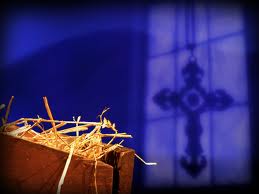About this time of year, our dogwood trees begin to start their annual show. Our trees are not hybridized trees, but naturalized as you would find them in the forest. And that's partly because these trees were part of the original farm grounds where our home is built, at the edge of some woods.
Ours trees look more like the ones to the right, than the full ones you might find growing free without other trees encroaching. I don't prefer one over the other -- both are beautiful as part of God's creation.
Perhaps you have hard of the legend of the dogwood tree. And if you have, I apologize for repeating it here. If you haven't, I hope you'll enjoy it.
Long before the Native Americans determined that the American dogwood was hard and therefore useful for making skewers or daggers, or smaller utilitarian tools, a culture already knew of the dogwood. That culture looked upon creation as the natural wonders offered at the hands of the Creator. Here began the legend of the dogwood tree identifying it with the Crucifixion.
What could be more natural as the delicately brilliant white blossoms dazzle man's vision in spring? In medieval times, man's passion at this time of year was focused entirely on the Passion of the Lord Jesus Christ, His suffering and the redeeming act of His love.
The blossoms are four-petaled, forming a cross with two short petals and two long ones. At the edge of each petal, you will find small holes, brown on one side and rusty on the other, reminiscent of the nails that pierced our Lord. The center of the blossom reflects the cross He was forced to wear.
I could attempt to rewrite for you here the words of the Legend handed down through the years, but I will choose to copy it in from
Tradition in Action:
"At the time of Our Lord’s
Crucifixion, the dogwood used to have the size of the oak and other
forest trees. Because the wood was so firm and strong and there were few
trees in the Middle East that were very large, it was chosen to be the
wood for the crosses used in crucifixions of criminals.
Thus, the wood of the cross that would bear Our Lord and Savior was made
from the dogwood tree. To be used thus for such a cruel purpose,
however, greatly distressed the tree. Sensing this, the crucified Christ
said to it:
'Because of your compassion and pity for My suffering, never again shall
the dogwood tree grow large enough to be used as a cross. Henceforth,
you shall be slender and bent and twisted and your blossoms shall be in
the form of a cross.
'On the outer edge of each petal there will be nail prints, and the
center of the flower will resemble the cruel crown of thorns placed on
My head, with bright red clusters once again recalling the blood I shed.
Thus, all who see this will remember Me.'"
No one seems to know when the legend first appeared. What can be gathered from this beautiful story is a reaction from people who were familiar with the Life, Death, and Resurrection of Jesus Christ and who were deeply moved by the imprints of His love around them. Inspiration for this legend must be a true and profound love for Christ.
When you were dead in your sins and in the uncircumcision of your
flesh, God made you alive with Christ. He forgave us all our sins,
having canceled the charge of our legal indebtedness, which stood
against us and condemned us; he has taken it away,
nailing it to the
cross. And having disarmed the powers and authorities,
he made a public spectacle of them, triumphing over them by the cross.
Moving ahead to a glorious Resurrection Sunday!


































